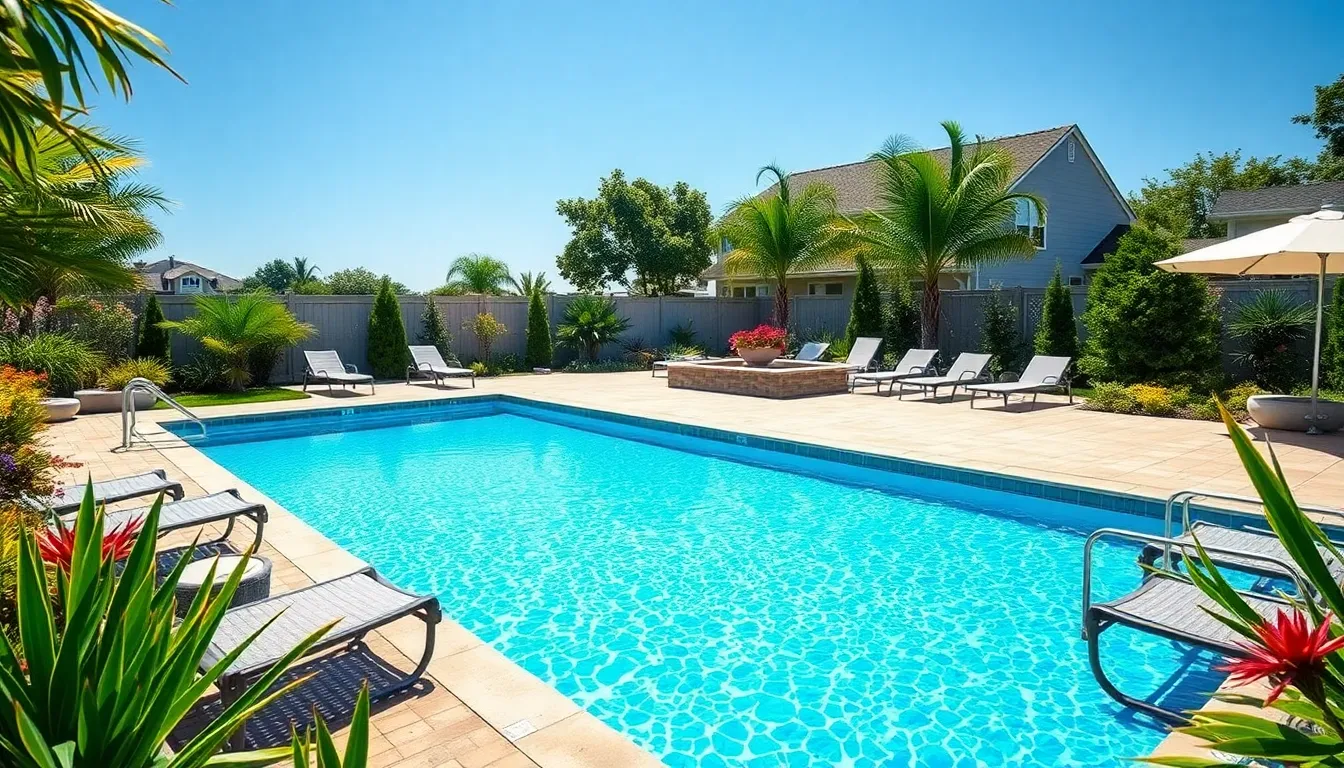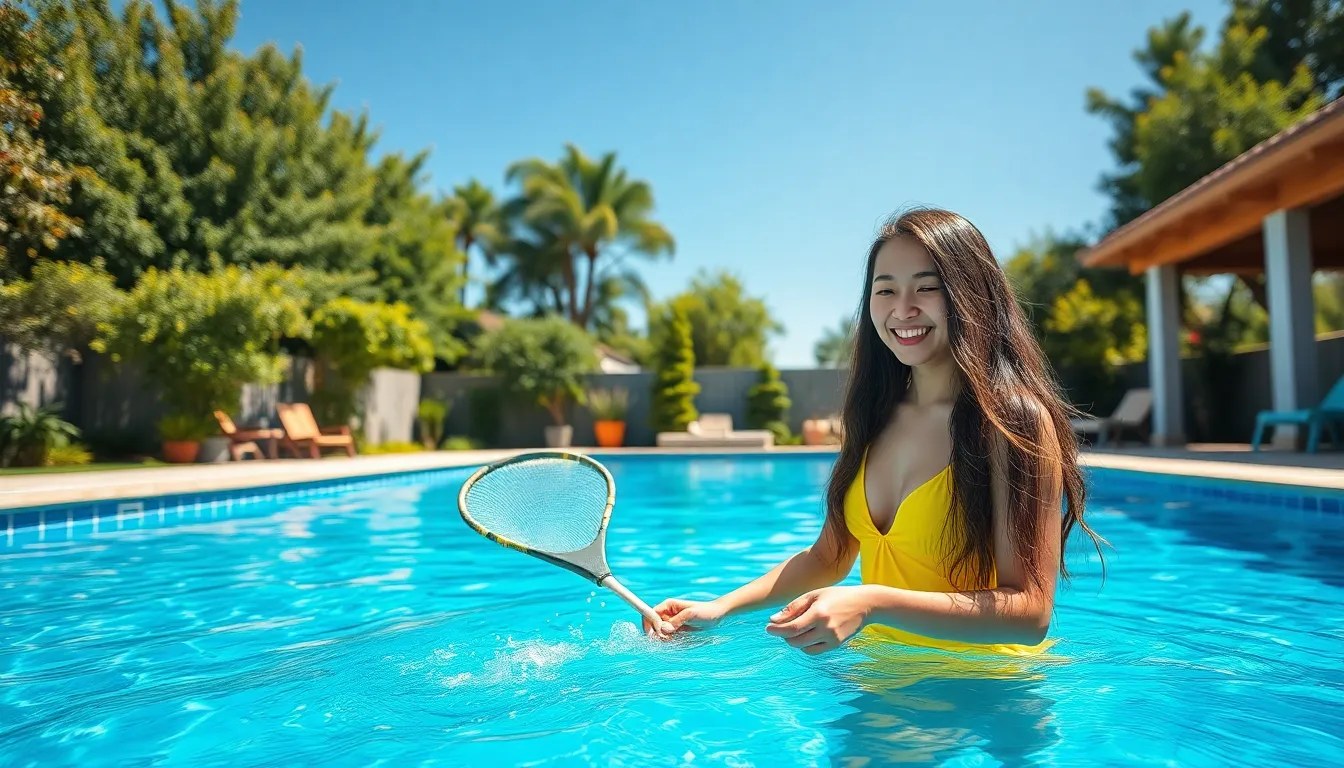When summer hits, nothing beats the refreshing splash of a clean pool. But let’s face it, keeping that crystal-clear oasis free from debris and unwanted guests can feel like a full-time job. If only pool maintenance came with a manual—or a magic wand! Fortunately, with a few simple tricks up your sleeve, you can turn your pool into a sparkling retreat that’ll have neighbors peeking over the fence in envy.
Table of Contents
ToggleUnderstanding Pool Water Contamination
Contaminants can compromise the quality of pool water. Identifying and addressing them is essential.
Common Contaminants
Bacteria and algae thrive in warm, stagnant water, making these common issues. Leaves, dirt, and insects also add to debris. Sunblock, body oils, and sweat affect water clarity and balance. Disinfectants like chlorine tackle these contaminants, but they require monitoring and adjustment regularly. Additionally, chemical imbalances or excessive mineral deposits pose further challenges.
Impact on Water Quality
Contaminated water discourages swimmers and can lead to infections. Untreated bacteria increase health risks significantly. Algae blooms turn water green and slimy, making it uninviting. Discolored water reduces visibility, making swimming less enjoyable. Regular maintenance prevents these issues, ensuring a safe environment and high-quality water. Poor water quality also strains filtration systems, leading to costly repairs. Keeping pool water clean enhances the overall swimming experience.
Essential Water Care Practices

Maintaining clean pool water requires diligent care. Implementing effective practices ensures a safe swimming environment.
Regular Testing and Balancing
Testing pool water at least once a week maintains proper chemical levels. pH levels should range between 7.2 and 7.8 for optimal sanitation. Alkalinity levels must stay between 80 and 120 parts per million (ppm) to stabilize pH. Chlorine levels also play a crucial role, with recommended concentrations of 1 to 3 ppm. Frequent testing identifies imbalances early, preventing serious issues like algae blooms or cloudy water. Adjusting chemicals promptly protects swimmers and keeps the pool inviting.
Importance of Filtration
A well-functioning filtration system removes debris and contaminants effectively. Filtration must operate at least 8 to 12 hours daily during peak usage months. Regular cleaning of the filter enhances its efficiency, preventing strain on the system. Filtering water helps maintain clarity and hygiene, reducing the need for excessive chemical treatment. A properly maintained filter prolongs the lifespan of pool equipment and conserves energy. It creates a consistently enjoyable swimming experience for all users.
Cleaning Tools and Equipment
Maintaining clean pool water requires the right tools and equipment. Various devices streamline the process of keeping a pool pristine and enjoyable.
Skimmers and Nets
Skimmers are essential for removing floating debris. They capture leaves, insects, and other unwanted materials before they sink. Using a leaf net can help as well; this tool effectively gathers larger debris swiftly. Regularly skimming the surface enhances overall cleanliness and reduces the workload for pool filters, allowing for optimal water circulation. It’s advisable to skim daily, especially during peak seasons.
Pool Brushes and Vacuums
Pool brushes assist in scrubbing walls and floors, eliminating algae and dirt buildup. Different brush types target various surfaces; a nylon brush works well for vinyl, while a stainless steel option is best for concrete. Vacuuming the pool collects debris that sinks to the bottom. Manual vacuums require operator input, whereas automatic models can operate independently. Weekly brushing and vacuuming maintain water clarity and prevent contamination, keeping the pool inviting for swimmers.
Chemical Treatments for Pool Water
Chemical treatments play a crucial role in keeping pool water clean and safe. Proper use of these chemicals helps maintain water quality and enhances the swimming experience.
Chlorine and Other Sanitizers
Chlorine effectively kills bacteria and other harmful microorganisms. Pool owners often use it to keep water sanitized. Liquid chlorine, tablets, and granules are some forms available. Alternatives like bromine and saltwater systems also provide effective sanitization. The ideal chlorine level ranges from 1 to 3 parts per million (ppm). Regularly checking this level ensures water remains safe for swimmers. Understanding the proper dosing and maintenance of chlorine not only prevents algae growth but also preserves water clarity.
Algaecides and Clarifiers
Algaecides protect against algae blooms that compromise water quality. They come in various formulations, with some preventing future growth, while others eliminate existing algae. Clarifiers improve water clarity by clumping small particles together, allowing the filter to capture them easily. Using them together can enhance pool conditions significantly. It’s recommended to follow instructions closely for optimal effectiveness. Maintaining proper chemical balance while using these treatments leads to a cleaner and healthier swimming environment. Regular use keeps pools sparkling and inviting.
Maintenance Tips for Optimal Cleanliness
Maintaining a clean swimming pool requires diligent effort throughout the seasons. Following a strategic approach simplifies the task and enhances water quality.
Seasonal Maintenance Checklist
A seasonal maintenance checklist ensures comprehensive care. Inspecting and cleaning the pool cover prevents debris buildup during winter. Spring offers a great time to assess equipment, checking for leaks or damages. Organizing all cleaning tools improves efficiency, while adjusting chemical levels prepares the pool for usage. Summer maintenance includes more frequent checks, as increased activity raises contamination levels. Fall requires tackling fallen leaves and debris to minimize staining and clogging.
Daily, Weekly, and Monthly Tasks
Daily tasks focus on quick cleanliness. Skimming the surface for leaves and debris should happen every day, especially during peak usage. Weekly responsibilities include testing water chemistry, adjusting pH, and chlorine levels as necessary. Brushing walls and vacuuming the pool encourage a pristine environment, while cleaning filter screens improves circulation. Monthly checks involve examining the filtration system’s performance, performing deep cleanings, and inspecting equipment for wear. Regular attention to these tasks leads to a sparkling pool experience, ensuring safety and enjoyment.
Maintaining clean pool water is essential for a safe and enjoyable swimming experience. By implementing regular testing and balancing of chemical levels along with diligent cleaning practices, pool owners can prevent common issues that lead to contamination. Utilizing the right tools like skimmers and brushes ensures that debris is promptly removed, while proper chemical treatments keep water clear and free from harmful algae.
With a proactive maintenance routine and attention to detail, it’s possible to enjoy a sparkling pool throughout the summer months. This commitment not only enhances the aesthetic appeal of the pool but also promotes health and safety for all swimmers. A well-maintained pool is a source of pride and enjoyment for any homeowner.



